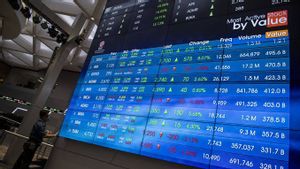JAKARTA - Last year investors were very serious about pouring money into Tesla Inc and its rival electric vehicle startups and hoped to emulate the success of Tesla CEO Elon Musk.
As interest rates rise and financial markets spiral, shares in many EV startups also decline. Rivian Automotive Inc, which has a higher market value than Ford Motor Co shortly after going public in 2021, lost more than 70% of its value over the past year.
Other EV startups fared even worse. Electric van maker Arrival warns that the cash could run out in less than a year. Lucid Group Inc, which is backed by Saudi Arabia's sovereign wealth fund, is striving to build the sleek Air luxury EV. Shares of Chinese challenger Tesla, Xpeng Inc also lost more than 80% in value.
The auto industry is spending more than $1 trillion on the revolutionary shift from combustion engines to software-guided electric vehicles. From Detroit to Shanghai, automakers and government policy makers have embraced the promise of electric vehicles to provide cleaner, safer transportation.
European countries and California have set 2035 as the deadline for ending sales of new combustion passenger vehicles.
Tesla Inc's surge to become the world's most valuable carmaker - reaching a USD 1 trillion (IDR 15611 trillion) valuation last year has overtaken established automakers such as Toyota Motor Corp and Volkswagen AG which were previously reluctant to switch to electric products.
Starting next year, a wave of new electric vehicles from pickup trucks to mid-market SUVs and sedans will hit the world market.
But industry executives and forecasters disagree on how quickly electric vehicles can take over half of the global vehicle market, let alone all of them.
In China, the world's largest single auto market, battery electric vehicles account for about 21% of the market. In Europe, EVs also account for around 12% of total passenger vehicle sales. But in the United States, EV market share is only about 6%.
Among the barriers to EV adoption, industry executives and analysts say, are a dearth of fast charging infrastructure for the public, and the rising cost of EV batteries, driven by shortages of key materials and uncertainty over government subsidies that have underpinned EV purchases in key markets, including the United States, China. and Europe.
According to AutoForecast Solutions, an automotive consultancy, estimates that by 2029, electric vehicles could reach a third of the North American market, and about 26% of vehicles produced worldwide,
"Sales of electric vehicles are unlikely to accelerate in a smooth, upward curve," said AFS President Joe McCabe. "If there is a recession next year, as many economists predict, it will slow EV adoption."
Wards Intelligence predicts that gas vehicles will account for less than 80% of North American sales by 2027. Based on the automaker's product plans, Wards analyst Haig Stoddard told a recent conference that the manufacturer "expects strong ICE (internal combustion engine) volumes." heading into the next decade."
Throughout 2022, established automakers such as Mercedes, Ford and General Motors Co. are rolling out dozens of new electric vehicles to challenge Tesla and other startups. Mass production of most of these vehicles begins in 2023 and 2024.
SEE ALSO:
"By 2025, there may be 74 different electric vehicle models offered in North America," McCabe said. But he estimates less than 20% of those models will likely sell at volumes above 50,000 vehicles per year. Automakers can get stuck with too many custom models and too many capacities.
The economic slowdown is also threatening overall vehicle demand in Europe and China.
During the early years of the 20th century, new auto companies emerged, supported by investors eager to catch the wave of mass mobility started by Henry Ford and other automotive pioneers. By the 1950s, the global automotive industry had consolidated and once-vaunted brands such as Duesenberg were disappearing.
The next few years will determine whether 21st century electric vehicle brands will follow the same path.
The English, Chinese, Japanese, Arabic, and French versions are automatically generated by the AI. So there may still be inaccuracies in translating, please always see Indonesian as our main language. (system supported by DigitalSiber.id)


















